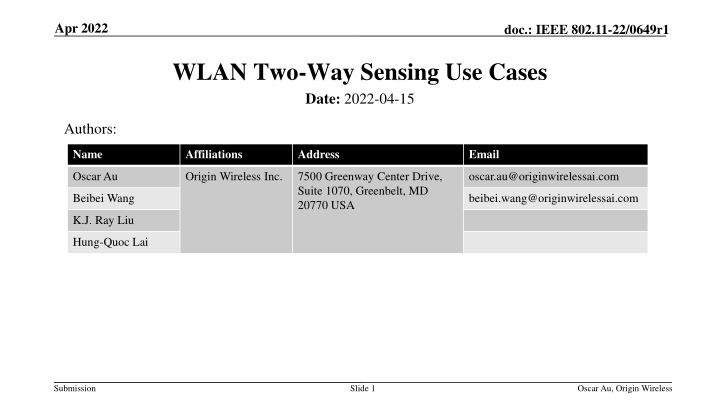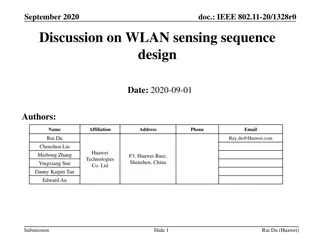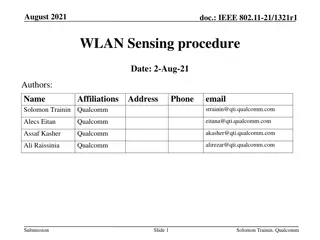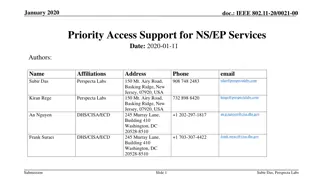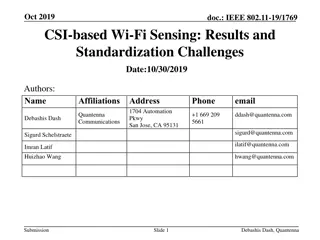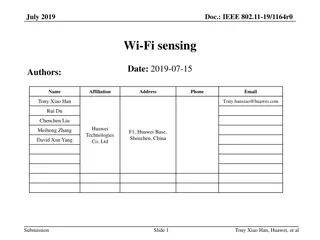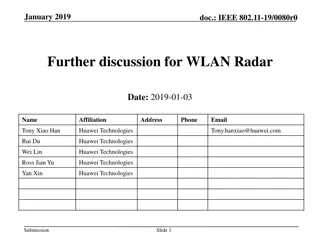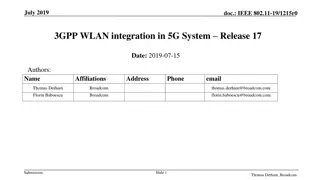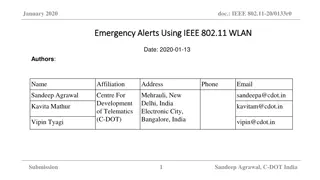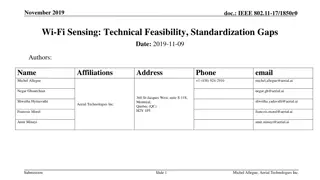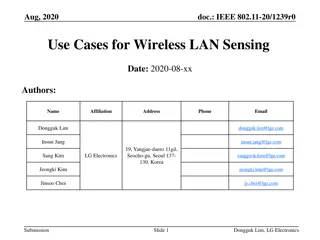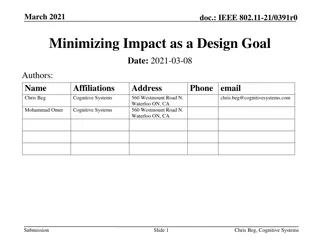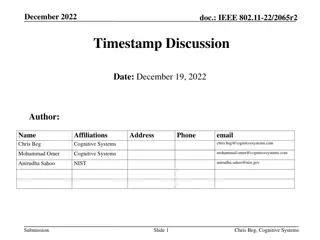IEEE 802.11-22 WLAN Two-Way Sensing Use Cases
This document explores the use cases and implementation of two-way sensing in WLAN environments, focusing on scenarios where both access points (AP) and non-AP stations require sensing results for various applications such as home security, presence detection, and sleep monitoring. The proposed approach supports efficient data exchange between initiators and responders to facilitate effective sensing operations in diverse IoT device ecosystems.
Download Presentation

Please find below an Image/Link to download the presentation.
The content on the website is provided AS IS for your information and personal use only. It may not be sold, licensed, or shared on other websites without obtaining consent from the author.If you encounter any issues during the download, it is possible that the publisher has removed the file from their server.
You are allowed to download the files provided on this website for personal or commercial use, subject to the condition that they are used lawfully. All files are the property of their respective owners.
The content on the website is provided AS IS for your information and personal use only. It may not be sold, licensed, or shared on other websites without obtaining consent from the author.
E N D
Presentation Transcript
Apr 2022 doc.: IEEE 802.11-22/0649r1 WLAN Two-Way Sensing Use Cases Date: 2022-04-15 Authors: Name Affiliations Address Email Oscar Au Origin Wireless Inc. 7500 Greenway Center Drive, Suite 1070, Greenbelt, MD 20770 USA oscar.au@originwirelessai.com Beibei Wang beibei.wang@originwirelessai.com K.J. Ray Liu Hung-Quoc Lai Submission Slide 1 Oscar Au, Origin Wireless
Apr 2022 doc.: IEEE 802.11-22/0649r1 Review of Non-TB sensing (Motion 39, 21/1433r2) One non-AP STA is sensing initiator and one AP is sensing responder. Non-AP STA transmits an NDPA and two consecutive NDPs: I2R and R2I NDP. If non-AP STA is only the sensing transmitter (uplink sounding), then I2R NDP is used to generate sensing measurement while the R2I NDP does not. If non-AP STA is only the sensing receiver (downlink sounding), then R2I NDP is used to generate sensing measurement while the I2R NDP does not. For uplink sounding Sensing NDPA I2R NDP Non-AP STA, sensing initiator SIFS SIFS Sensing Measurement Report frame For uplink sounding R2I NDP AP, sensing responder For downlink sounding Submission Slide 2 Oscar Au, Origin Wireless
Apr 2022 doc.: IEEE 802.11-22/0649r1 Use case: Two-way sensing One-way sensing: In a TB or non-TB sensing instance, the sensing initiator can send NDP to sensing responder to generate sensing results, and sensing responder can use sensing measurement report frames to send sensing results to sensing initiator. Alternatively, sensing responder can send NDP to generate sensing results at sensing initiator. 2-way sensing use case: There are some use cases in which both AP and non-AP need sensing results. E.g. one performs a sensing task while the other performs another sensing task. We propose that 11bf should support two-way sensing use case. E.g. a home router (AP) may run motion detection application for home security, while a TV (non-AP STA) may run presence detection for improved TV viewing experience and a bedroom device (non-AP STA) may run sleep monitoring for sleep well-being applications. Both AP and TV may need sensing result. Both AP and bedroom device may need sensing results. AP may run WLAN sensing applications from AP vendor or ISP, while non-AP STAs (consumer electronics, IoT devices, high-end, low-end, etc) may run WLAN sensing applications from consumer electronics/IoT device manufacturers. The AP applications and non-AP STAs applications tend to be different due to different goals. A home may have 10 to 20 IoT devices. This two-way sensing need may arise in a majority of the IoT devices. Submission Slide 3 Oscar Au, Origin Wireless
Apr 2022 doc.: IEEE 802.11-22/0649r1 Two-way Non-TB sensing Non-TB sensing (initiator=non-AP, responder=AP) already has both I2R and R2I NDP. We can simply use them. Two-way sensing for non-TB sensing: In a non-TB sensing instance, both I2R NDP (uplink sounding) and R2I NDP (downlink sounding) can be used to generate sensing results at AP and non-AP respectively. There is NO NEED for AP (sensing responder) to use sensing measurement report frame to transmit its sensing measurement result to non-AP STA (sensing initiator), because the non- AP STA has its own sensing results. Submission Slide 4 Oscar Au, Origin Wireless
Apr 2022 doc.: IEEE 802.11-22/0649r1 Non-TB sensing Sensing initiator (non-AP STA) Sensing responder (AP) MLME SME MLME SME MLME-SENS NTB MSMT RQ.request NDPA MLME-SENS NTB REPORT.indication NDP MLME-SENS NTB REPORT RQ.request MLME-SENS NTB MSMT RQ.confirm MLME-SENS NTB REPORT RQ.confirm Sensing Measurement Report frame One-way non-TB sensing: (Uplink sounding) sensing measurement results reported from AP to Non-AP STA. NDPA MLME-SENS NTB REPORT.indication NDP One-way non-TB sensing: (Downlink sounding) sensing measurement at Non-AP STA; No sensing measurement report frame. Submission Slide 5 Oscar Au, Origin Wireless
Apr 2022 doc.: IEEE 802.11-22/0649r1 Non-TB sensing Sensing initiator (non-AP STA) Sensing responder (AP) MLME SME MLME SME MLME-SENS NTB MSMT RQ.request NDPA MLME-SENS NTB REPORT.indication NDP MLME-SENS NTB REPORT RQ.request MLME-SENS NTB MSMT RQ.confirm MLME-SENS NTB REPORT RQ.confirm Sensing Measurement Report frame One-way non-TB sensing: (Uplink sounding) sensing measurement results reported from AP to Non-AP STA. NDPA MLME-SENS NTB REPORT.indication NDP One-way non-TB sensing: (Downlink sounding) sensing measurement at Non-AP STA; No sensing measurement report frame. NDPA MLME-SENSNTBREPORT.indication NDP MLME-SENSNTBREPORT.indication NDP Two-way non-TB sensing: (uplink + downlink sounding) sensing measurement at both AP and non-AP STA; No sensing measurement report frame. Submission Slide 6 Oscar Au, Origin Wireless
Apr 2022 doc.: IEEE 802.11-22/0649r1 Two-way TB sensing In TB sensing (initiator=AP, responder=non-AP), AP uses either NDPA frame (downlink sounding) or Trigger Frame (uplink sounding) to signal the transmission of NDP, which is one- way sensing. Two-way sensing for TB sensing: In a TB sensing instance, AP can send a Two-way Trigger Frame (e.g. we can re-use Trigger Frame or NDPA frame), followed by both I2R and R2I NDP such that sensing results are generated at both AP and non-AP. NO NEED for sensing responder (non-AP) to use sensing measurement report frame to transmit its sensing measurement result to sensing initiator (AP), because the sensing initiator has its own sensing results. Submission Slide 7 Oscar Au, Origin Wireless
Apr 2022 doc.: IEEE 802.11-22/0649r1 TB sensing Sensing initiator (AP) Sensing responder (non-AP STA) MLME SME MLME SME MLME-SENS TB MSMT RQ.request SENS Poll Frame CTS-to-self SENS NDPA Frame MLME-SENS TB REPORT.indication NDP MLME-SENS TB REPORT RQ.request MLME-SENS TB MSMT RQ.confirm MLME-SENS TB REPORT RQ.confirm Sensing Measurement Report frame One-way TB sensing: (Downlink sounding) sensing measurement results reported from non-AP to AP using report frame. SENS Trigger Frame MLME-SENS TB REPORT.indication NDP One-way TB sensing: (Uplink sounding) sensing measurement at AP; No sensing measurement report frame. Submission Slide 8 Oscar Au, Origin Wireless
Apr 2022 doc.: IEEE 802.11-22/0649r1 TB sensing Sensing initiator (AP) Sensing responder (non-AP STA) MLME SME MLME SME MLME-SENS TB MSMT RQ.request SENS Poll Frame CTS-to-self SENS NDPA Frame MLME-SENS TB REPORT.indication NDP MLME-SENS TB REPORT RQ.request MLME-SENS TB MSMT RQ.confirm One-way TB sensing: (Downlink sounding) sensing measurement results reported from non-AP to AP using report frame. MLME-SENS TB REPORT RQ.confirm Sensing Measurement Report frame SENS Trigger Frame MLME-SENS TB REPORT.indication One-way TB sensing: (Uplink sounding) sensing measurement at AP; no report frame. NDP Two-way Trigger Frame MLME-SENS TB REPORT.indication NDP MLME-SENS TB REPORT.indication NDP Two-way TB sensing: (Downlink/uplink sounding) sensing measurement at both AP/non-AP STA; no report frame. Submission Slide 9 Oscar Au, Origin Wireless
Apr 2022 doc.: IEEE 802.11-22/0649r1 Comparison with NDPA sounding/TF sounding One of NDPA sounding and TF sounding Report frame optional Overhead - one sounding Sounding frequency controlled by AP Proposed two-way sensing Both of NDPA sounding and TF sounding Report frame optional Overhead - two soundings Sounding frequency can be different for AP and non-AP STA Non-AP STA in sleep mode wake up once/ twice, longer No report frame Overhead - one sounding Sounding frequency - same for AP/non-AP STA Non-AP STA in sleep mode - wake up once Non-AP STA in sleep mode - wake up once Submission Slide 10 Oscar Au, Origin Wireless
Apr 2022 doc.: IEEE 802.11-22/0649r1 Straw Poll (SP1) Do you agree to add the following to SFD and D0.1? Two-way sensing within a sensing measurement instance is supported. 1. 2. 3. Yes No Abstain Submission Slide 11 Oscar Au, Origin Wireless
Apr 2022 doc.: IEEE 802.11-22/0649r1 Straw Poll (SP2) Do you agree to add the following to the SFD (D0.1)? A sensing measurement instance shall optionally support transmission of both forward NDP (e.g. I2R NDP) and backward NDP (R2I NDP) in tendon to generate sensing measurement results in each of a pair of sensing transmitter and sensing receiver. 1. 2. 3. Yes No Abstain Submission Slide 12 Oscar Au, Origin Wireless
Apr 2022 doc.: IEEE 802.11-22/0649r1 Straw Poll (SP3) Do you agree with the following? In sensing measurement instance performing the proposed two-way sensing, sensing measurement report frames shall NOT be used to transmit sensing measurement results. 1. 2. 3. Yes No Abstain Submission Slide 13 Oscar Au, Origin Wireless
Apr 2022 doc.: IEEE 802.11-22/0649r1 Straw Poll (SP4) In two-way TB sensing use cases, which one of the following do you prefer to use as Two-way Trigger frame to signal the transmission of I2R and R2I NDPs? 1. 2. 3. 4. NDPA frame Trigger frame Another frame Abstain Submission Slide 14 Oscar Au, Origin Wireless
